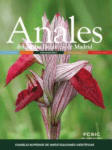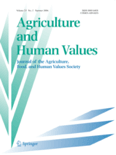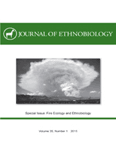
ECONOMIC BOTANY
Scope & Guideline
Harnessing Botanical Research for Economic Growth
Introduction
Aims and Scopes
- Ethnobotany and Cultural Practices:
A core focus on how different cultures utilize plants for food, medicine, and cultural rituals, thereby documenting traditional knowledge and practices. - Sustainability and Conservation:
Research emphasizes sustainable practices in plant use and conservation strategies for threatened plant species, highlighting the balance between human needs and ecological preservation. - Economic Botany and Trade:
Investigation into the economic aspects of plant usage, including trade dynamics, market values of wild and cultivated plants, and the impact of globalization on local economies. - Methodological Innovations:
Emphasis on developing and applying innovative methodologies for studying plant-human interactions, including qualitative and quantitative research approaches in ethnobotany. - Interdisciplinary Approaches:
Integration of various disciplines such as anthropology, ecology, and economics to provide a holistic understanding of the role of plants in human societies.
Trending and Emerging
- Gender and Ethnobotany:
Research increasingly addresses the role of gender in plant use and knowledge transmission, highlighting the importance of gender equity in ethnobotanical studies. - Citizen Science and Community Engagement:
There is a rising trend in involving local communities and citizen scientists in ethnobotanical research, fostering collaboration and enhancing the relevance of findings for local practices. - Food Security and Nutrition:
Emerging studies focus on the role of indigenous and wild plants in food security, nutrition, and health, particularly in the context of global challenges such as climate change. - Cultural Keystone Species:
A growing emphasis on identifying and preserving cultural keystone species that play significant roles in the identity and well-being of specific communities. - Impact of Climate Change on Plant Use:
Research increasingly explores how climate change affects plant availability, use patterns, and traditional ecological knowledge, reflecting urgent contemporary concerns.
Declining or Waning
- Traditional Agricultural Practices:
Research on traditional agricultural systems and crop management practices, while still relevant, has seen less frequency in recent publications compared to emerging topics like ethnobotanical trade and sustainability. - Historical Ethnobotany:
Studies focusing on historical perspectives of plant use and ancient agricultural practices are becoming less common, as contemporary applications and socio-economic impacts gain prominence. - General Biodiversity Studies:
While biodiversity remains a crucial topic, specific studies solely addressing plant biodiversity without the context of human interaction or economic implications are declining.
Similar Journals

ANALES DEL JARDIN BOTANICO DE MADRID
Unveiling the Wonders of Flora and EcosystemsANALES DEL JARDIN BOTANICO DE MADRID is a prominent open-access journal dedicated to the field of Botany, specifically focusing on both Plant Sciences and the broader domains of Ecology, Evolution, Behavior, and Systematics. Published by the esteemed CONSEJO SUPERIOR INVESTIGACIONES CIENTIFICAS-CSIC, this journal has been a vital source of knowledge and academic discourse since its inception. The journal has an ongoing commitment to disseminating research findings, with open access established since 1997, thereby ensuring that valuable scientific insights are readily available to researchers, professionals, and students worldwide. With an impact factor that reflects its relevance in the field and ranked in the Q3 category for Ecology, Evolution, Behavior and Systematics and Plant Science for the year 2023, ANALES DEL JARDIN BOTANICO DE MADRID serves as an essential platform for the publication of innovative studies and the exchange of ideas in the botanical community. The journal covers a variety of topics, from plant morphology and taxonomy to conservation biology, contributing significantly to the advancement of botanical sciences. Researchers looking to enrich their work and engage with a global audience will find this journal an invaluable resource.

Plants People Planet
Exploring the Synergy of Flora and Society.Plants People Planet is a leading academic journal published by Wiley, focusing on the intricate relationships between plants, people, and the planet. Since its debut as an Open Access publication in 2019, it has quickly established a significant presence in the scholarly community, achieving impressive rankings in multiple categories. Notably, it holds a prestigious Q1 ranking in Ecology, Evolution, Behavior and Systematics, Forestry, Horticulture, and Plant Science as of 2023. With its dedicated scope addressing crucial ecological and horticultural advancements, this journal is essential for researchers, professionals, and students who aim to explore interdisciplinary approaches to sustainable plant management and environmental stewardship. Operating from the United Kingdom, it serves a global audience of scholars, providing an invaluable platform for disseminating innovative research and fostering collaborative dialogue in these pivotal fields. For those interested in cutting-edge research that bridges the gap between human practices and ecological health, Plants People Planet is a must-publish venue.

Acta Botanica Mexicana
Connecting global researchers to ecological challenges.Acta Botanica Mexicana is a premier journal published by Instituto de Ecología AC, dedicated to advancing research in the fields of ecology, plant science, and biological sciences. With an E-ISSN of 2448-7589, this open-access journal facilitates extensive dissemination of scientific findings, ensuring that knowledge is accessible to researchers, professionals, and students worldwide. Established in 2008, Acta Botanica Mexicana has earned a notable reputation, achieving a Q3 ranking in plant science and a Q4 ranking in ecology and evolution for 2023. This positioning underscores its commitment to publishing high-quality research that addresses vital issues in ecological and botanical studies. With a focus on innovative methodologies and pragmatic solutions, the journal invites contributors to share their insights and findings, thus enriching the academic landscape and fostering collaborations that drive the field forward. The journal is based in Michoacán, Mexico, and serves as a key hub for researchers engaging with the challenges and intricacies of plant and ecological studies.

Botanical Sciences
Fostering innovation and discovery in botanical research.Botanical Sciences, published by SOC BOTANICA MEXICO, is a pioneering open access journal dedicated to advancing the field of plant science. Established in 2012, it has rapidly become an essential resource for researchers and professionals interested in the diverse aspects of botany, including plant biology, ecology, and conservation. With an ISSN of 2007-4298 and an E-ISSN of 2007-4476, the journal operates under a vision to foster the exchange of knowledge and innovations among scientists globally. Recognized in the Q3 quartile for plant science in 2023 and ranking at #304 out of 516 in the Scopus category for Agricultural and Biological Sciences, Botanical Sciences is strategically positioned to widen its reach and impact. The journal's commitment to open access ensures that research findings are freely available to an international audience, providing invaluable insights and fostering collaboration within the botanical sciences community. The editorial board comprises leading experts who are dedicated to maintaining high-quality peer review processes to uphold the standards expected by the academic community.

AGRICULTURE AND HUMAN VALUES
Exploring the nexus of agriculture and human well-being.AGRICULTURE AND HUMAN VALUES is a leading interdisciplinary journal published by SPRINGER, focusing on the intricate relationships between agricultural practices, environmental sustainability, and human well-being. With an impressive impact factor and ranking in the Q1 quartile across various fields including Agronomy and Crop Science, Geography, Planning and Development, and Sociology and Political Science, this journal provides a vital platform for researchers and professionals to explore the social, economic, and cultural dimensions of agriculture. As a prominent outlet since its inception in 1984, it aims to contribute to the dialogue on sustainable practices and policies that impact food systems globally. The journal caters to a diverse readership, including scholars, policymakers, and students, ensuring that critical research findings reach those who can influence change. With a solid reputation and commitment to advancing knowledge in these essential areas, AGRICULTURE AND HUMAN VALUES remains an invaluable resource for those dedicated to improving agricultural practices and human health in a rapidly changing world.

ANTHROPOLOGY OF CONSCIOUSNESS
Charting New Territories in the Anthropology of MindAnthropology of Consciousness is a prestigious journal published by Wiley, focusing on the intricate ties between consciousness and anthropology. With its ISSN 1053-4202 and E-ISSN 1556-3537, this journal has established itself as a key platform for scholars investigating the cognitive, cultural, and experiential dimensions of consciousness. Operating since 1990 and with converged years extending to 2024, it has achieved a commendable Q2 ranking in Anthropology for 2023, reflecting its significance in the field. Although it is not an open-access journal, it provides robust access options through various university and library subscriptions. The journal aims to disseminate high-quality research and foster interdisciplinary dialogue among researchers, professionals, and students interested in the anthropological aspects of consciousness. With its address located at 111 River St, Hoboken 07030-5774, NJ, United States, it continues to be a vital resource for those exploring the depths of human experience.

Annali di Botanica
Connecting researchers to the world of botany.Annali di Botanica is a distinguished journal published by UNIV STUDI ROMA LA SAPIENZA that has become a vital platform for advancing research in the field of plant sciences. With its Open Access policy established since 1995, it ensures that a wide audience including researchers, professionals, and students can access high-quality, peer-reviewed articles that contribute to the global body of botanical knowledge. As of 2023, the journal holds a Q3 rank in the Plant Science category, reflecting its commitment to scholarly excellence and relevance, as evidenced by its position within the 62nd percentile of activities ranked in Scopus. The journal encompasses diverse topics in botany, fostering discussions that encompass morphological, ecological, and genetic aspects of plants, effectively bridging theoretical knowledge and practical applications. Situated in the heart of Rome, Italy, at PIAZZALE ALDO MORO, 5, the journal not only addresses regional botanical issues but aims to serve a global audience, enhancing collaborative efforts and stimulating innovation across the botanical sciences.

JOURNAL OF ETHNOBIOLOGY
Celebrating the Synergy of Science and TraditionJOURNAL OF ETHNOBIOLOGY, published by SAGE PUBLICATIONS INC, stands at the forefront of interdisciplinary research in the fields of ethnobiology, anthropology, and the biological sciences. With an ISSN of 0278-0771 and an E-ISSN of 2162-4496, this esteemed journal boasts a remarkable impact, categorized as Q1 in both Animal Science and Zoology, Anthropology, and Plant Science as of 2023. Ranking in the top percentiles among its peers on Scopus—29th in Anthropology and 69th in Animal Science—this journal plays a critical role in advancing our understanding of the complex relationships between humans and their biological environments. Covering a wide array of topics from traditional ecological knowledge to conservation strategies, the JOURNAL OF ETHNOBIOLOGY is dedicated to fostering scientific dialogue and innovation. With an emphasis on original research and reviews, the journal serves as an essential resource for researchers, professionals, and students alike, facilitating a deeper comprehension of the intricate networks of life that sustain our planet. The journal's contributions significantly influence both theoretical and practical applications in biodiversity and cultural heritage, making it indispensable for anyone engaged in these vital fields.

Mediterranean Botany
Connecting Research and Conservation in Mediterranean EcosystemsMediterranean Botany is a distinguished peer-reviewed journal dedicated to the flourishing fields of Ecology, Plant Science, and Ecology, Evolution, Behavior and Systematics. Published by the Universidad Complutense de Madrid, Servicio Publicaciones, this Open Access journal has been disseminating valuable research since 2018, ensuring that findings are accessible to a global audience, with an emphasis on Mediterranean vegetation and biodiversity. With an ISSN of 2603-9109, it contributes significantly to the academic discourse in its category quartiles, recently featuring in Q3 for Ecology and related fields. Notably, Mediterranean Botany ranks within the top half of its category in Scopus, highlighting its relevance and contribution to the scientific community. Researchers, professionals, and students alike will find the journal to be a vital resource for latest discoveries, trends, and conservation strategies in Mediterranean ecosystems, positioning it as an essential platform for advancing knowledge and fostering collaboration within the plant sciences.

Journal of Ethnobiology and Ethnomedicine
Illuminating the Path from Cultural Heritage to Scientific DiscoveryJournal of Ethnobiology and Ethnomedicine, published by BMC in the United Kingdom, is a premier open-access journal that has been at the forefront of interdisciplinary scholarship since its inception in 2005. With its focus on the intricate relationships between humans and their biological environments, the journal serves as a vital resource for researchers, professionals, and students alike. It boasts a remarkable impact, reflected in its status as a Q1 journal in prominent categories such as Agricultural and Biological Sciences, Complementary and Alternative Medicine, and Cultural Studies. The journal is indexed in Scopus, where it ranks impressively high, including a top 1% position in Cultural Studies and a notable 90th percentile ranking in Complementary and Alternative Medicine. By providing open access to insightful articles that bridge empirical research and cultural knowledge, the Journal of Ethnobiology and Ethnomedicine plays a crucial role in advancing the discourse surrounding traditional practices and their implications for health and sustainability. Join us in exploring this fascinating domain where science meets cultural wisdom.